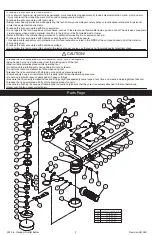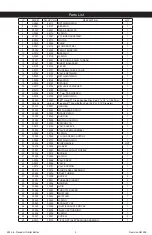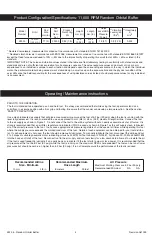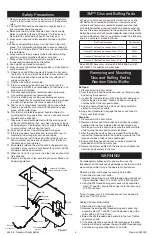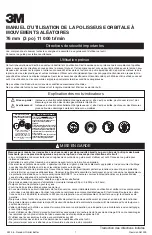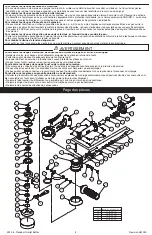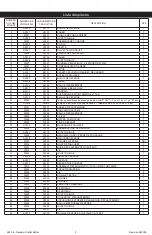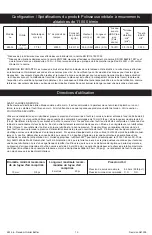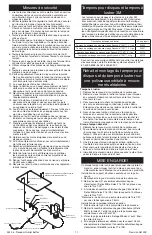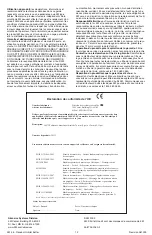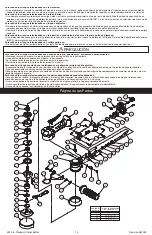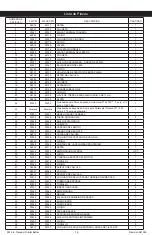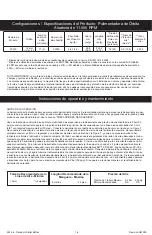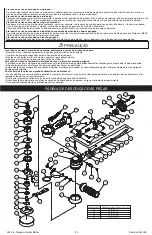
3M 3 in. Random Orbital Buffer
5
Revision 06009
Safety Precautions
. Read all instructions before using this tool. All operators
must be fully trained in its use and aware of these safety
rules.
2. The tool RPM should be checked on a regular basis to
ensure proper operating speed.
3. Make sure the tool is disconnected from the air supply.
Select a suitable buff pad and secure it to the disc pad.
Be careful to center the buff pad on the disc pad.
. Always wear required safety equipment when using this
tool.
5. When sanding/buffing always start the tool on the work-
piece. This will prevent gouging due to excess speed of
the buff pad. Stop air flow to the tool as it is removed from
the workpiece.
6. Always remove the air supply to the buffer before fitting,
adjusting or removing the buff pad or disc pad.
7. Always adopt a firm footing and grip and be aware of
torque reaction developed by the buffer.
8. Use only 3M approved spare parts.
9. Always ensure the material being sanded is firmly fixed to
avoid movement.
0. Check hose and fittings regularly for wear. Do not carry
the tool by its hose; always be careful to prevent the tool
from being started when carrying the tool with the air
supply connected.
. Dust can be highly combustible.
2. If tool is serviced or rebuilt check to ensure that the
maximum tool RPM is not exceeded and that there is no
excessive tool vibration.
3. Do not exceed maximum recommended air pressure.
Use safety equipment as recommended.
. Prior to installing any sanding or polishing accessory,
always check that it’s marked maximum operating speed
is equal or higher than the rated speed of this tool.
5. The tool is not electrically insulated. Do not use where
there is a possibility of contact with live electricity, gas
pipes, and/or water pipes.
6. This tool is not protected against hazards inherent in
grinding and cutting operations, and no such accessories
should ever be attached.
7. Take care to avoid entanglement with the moving parts
of the tool with clothing, ties, hair, cleaning rags or loose
hanging objects. If entangled, stop air supply immediately
to avoid contact with moving tool parts.
8. Keep hands clear of the spinning pad during use.
9. If the tool appears to malfunction, remove from use im-
mediately and arrange for service and repair.
20. Do not allow the tool to free spin without taking precau-
tions to protect any persons or objects from the loss of
the abrasive or pad ruptures.
2. Immediately release the start handle in the event of any
disruption of pressure; do not attempt to re-start until the
disruption has been corrected.
22. When tool is not in use, store in a clean, dry environment
free of debris.
23. Recycle or dispose of tool according to Local, State, and
Federal regulations.
3M™ Disc and Buffing Pads
3M disc and buff pads are perfectly mated for use on the
3M Buffer. Constructed from premium, industrial-quality
materials and featuring a riveted fiberglass and steel hub
with molded urethane, their durability and precise construc-
tion are the ideal complement to the performance of the 3M
Buffer. See Product Configuration/Specifications table for the
correct replacement pad for a particular model. The following
chart is a sample of products offered.
Figure
Closed Loop Pipe System
Sloped in the direction of air flow
Drain Leg
Ball Valve
To Tool Station
Filter
Drain Valve
Regulator
Lubricator
Ball
Valve
Ball Valve
Air Flow
Air Dryer
Air Compressor
and Tank
Air Hose
To Coupler
at or near Tool
Removing and Mounting
Disc and Buffing Pad to
Random Orbital Buffer
Buff pad
. Disconnect air line from buffer.
2. Peel the old buff pad from the disc pad, by lifting an edge
and puling firmly upward.
3. Inspect the Hook material on the disc pad for damage or
debris clogging the hooks. Clean any debris or buffing
compound from the disc pad surface.
. Attach a new buff pad to the disc pad, being careful to
center it as well as possible.
5. Apply hand pressure to engage the hooks and loops to
firmly seat the buff pad.
Disc pad
. Disconnect air line from buffer.
2. Remove old disc pad from buffer by inserting the wrench,
supplied with the tool, between the rubber shroud and
the disc pad. Use the wrench to secure the buffer spindle
while turning the disc pad counter clockwise.
3. After the old disc pad has been removed from the buffer,
inspect the threaded hole in the spindle to ensure that the
threads are free of debris and undamaged.
. Ensure that the phenolic washer is in place around the
threaded shaft of the new disc pad.
5. Secure the buffer spindle with the wrench and tighten the
new disc pad securely to the tool.
See 3M ASD Accessory catalog 6-5002-8098-9 and 6-
5002-8097- for additional Accessories.
WARNING!
An inadequately tightened disc pad could cause the
threaded shaft to break causing damage to the tool and work
piece and possible injury to the operator or bystanders.
Mounting rubber tool hanger accessory onto buffer
. Disconnect air line from buffer;
2. Remove the existing two (2) M8 threaded plug and spacer
ring assemblies (items 27 and 28) with T-20 Torx driver*,
3. Using the M8 threaded plug and spacer ring assemblies
(items 27 and 28), secure the hanger onto the tool using
a T-20 Torx driver*.
*Note: if necessary a 2.5mm Allen wrench may be used in
place of a T-20 Torx driver
Adding Optional Side-Handle
. Disconnect air line from buffer.
2. Remove the existing M8 threaded plug and spacer ring
assembly (items 27 and 28) from the desired side of the
buffer with a T-20 Torx driver*.
3. Screw the M8 threaded side handle into the tool. Tighten
securely by hand.
. If the Side–Handle is used with the tool hanger, the Side–
Handle will directly replaces the existing M8 threaded plug
and spacer ring assembly (items 27 and 28).
Buff Pad Description
Part Number
Finesse-it™ Buffing Pad, Orange Foam, 3
1
/
4
in.
02648
Finesse-it™ Buffing Pad, Orange Foam, 3
3
/
4
in,
02637
Finesse-it™ Buffing Pad, Grey Foam, 3
1
/
4
in.
25134
Finesse-it™ Buffing Pad, Grey Foam, 3
3
/
4
in,
25135


